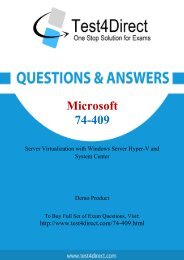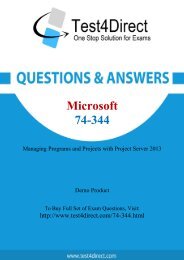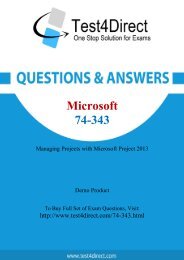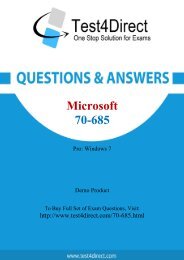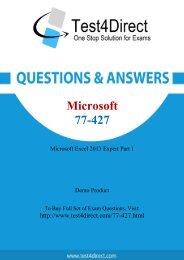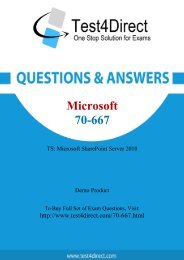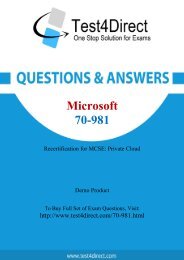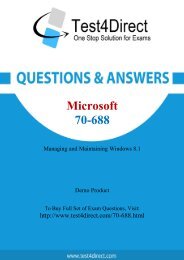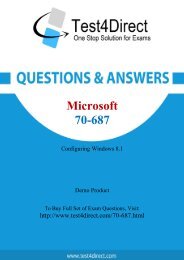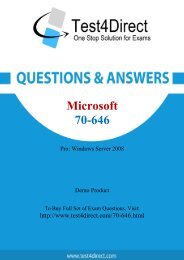Pass 70-243 Exam Easily with BrainDumps
Test4Direct provides latest PDF questions of Microsoft 70-243 exam. You have an opportunity to pass the Microsoft 70-243 exam in one go. Test4Direct is most accurate source to prepare Microsoft 70-243 exam as your success will become site’s responsibility after purchasing 70-243 exam product. There are also lots of discounts and promotion offers that you can avail. Let’s try a free demo http://www.test4direct.com/70-243.html
Test4Direct provides latest PDF questions of Microsoft 70-243 exam. You have an opportunity to pass the Microsoft 70-243 exam in one go. Test4Direct is most accurate source to prepare Microsoft 70-243 exam as your success will become site’s responsibility after purchasing 70-243 exam product. There are also lots of discounts and promotion offers that you can avail. Let’s try a free demo http://www.test4direct.com/70-243.html
Create successful ePaper yourself
Turn your PDF publications into a flip-book with our unique Google optimized e-Paper software.
Microsoft<br />
<strong>70</strong>-<strong>243</strong><br />
Administering and Deploying System Center 2012<br />
Configuration Manager<br />
Demo Product<br />
To Buy Full Set of <strong>Exam</strong> Questions, Visit:<br />
http://www.test4direct.com/<strong>70</strong>-<strong>243</strong>.html
Version: 18.0<br />
Question: 1<br />
You recently migrated from System Center Configuration Manager 2007 to System Center 2012<br />
Configuration Manager.<br />
Your network contains a client computer that runs the 64-bit version of Windows 7 and the 32-bit<br />
version of Windows 7.<br />
Some client computers have the Microsoft Application Virtualization (App-V) client installed.<br />
You have an Application named App1.<br />
You have a 64-bit version of App1, a 32-bit version of App1, and a virtual version of App1.<br />
You need to deploy the Application to all of the client computers.<br />
The solution must minimize the amount of administrative effort.<br />
What should you do?<br />
A. Create a new Application that has three different deployment types and create a target collection<br />
for each of the deployment types.<br />
B. Create a new Application that has three different deployment types and configure global<br />
conditions for each of the deployment types.<br />
C. Create a new package for each version of App1.<br />
D. Create a new Application for each version of App1.<br />
Answer: B<br />
Explanation:<br />
How to Create Deployment Types in Configuration Manager<br />
Supplemental Procedures to Create a Deployment Type<br />
Step 6: Specify Requirements for the Deployment Type<br />
1. On the Requirements page of the Create Deployment Type Wizard, click Add to open the Create<br />
Requirement dialog box, and add a new requirement.<br />
2. From the Category drop-down list, select whether this requirement is for a device or a user, or<br />
select Custom to use a previously created global condition. When you select Custom, you can also<br />
click Create to create a new global condition. For more information about global conditions, see How<br />
to Create Global Conditions in Configuration Manager.<br />
3. From the Condition drop-down list, select the condition that you want to use to assess whether<br />
the user or device meets the installation requirements. The contents of this list will vary depending<br />
on the selected category.<br />
4. From the Operator drop-down list, choose the operator that will be used to compare the selected<br />
condition to the specified value to assess whether the user or device meets in the installation<br />
requirement.<br />
The available operators will vary depending on the selected condition.<br />
5. In the Value field, specify the values that will be used <strong>with</strong> the selected condition and operator<br />
whether the user or device meets in the installation requirement. The available values will vary<br />
depending on the selected condition and the selected operator.<br />
6. Click OK to save the requirement rule and exit the Create Requirement dialog box.<br />
7. On the Requirements page of the Create Deployment Type Wizard, click Next.
Reference: How to Create Deployment Types in Configuration Manager<br />
http://technet.microsoft.com/en-us/library/gg682174.aspx#BKMK_Step2<br />
Question: 2<br />
You network contains a System Center 2012 R2 Configuration Manager Service Pack 1 (SP1)<br />
environment.<br />
You have an application named App1.<br />
You need to ensure that users in the finance department can install App1 by using the Application<br />
Catalog.<br />
What should you do?<br />
A. Create a required user deployment and target the deployment to all of the finance department<br />
users.<br />
B. Create a required user deployment and target the deployment to all of the client computers in the<br />
finance department.<br />
C. Create an available user deployment and target the deployment to all of the finance department<br />
users.<br />
D. Create an available user deployment and target the deployment to all of the client computers in
the finance department.<br />
Question: 3<br />
Answer: C<br />
Explanation:<br />
By selecting "Available" it will be selectable for the users in the Application Catalog.<br />
The "Required" option would force the installation to all users in the finance department.<br />
Reference: How to Deploy Applications in Configuration Manager<br />
http://technet.microsoft.com/en-us/library/gg682082.aspx<br />
Note: To deploy an application<br />
...<br />
8. On the Deployment Settings page of the Deploy Software Wizard, specify the following<br />
information:<br />
* Action – From the drop-down list, choose whether this deployment is intended to Install or<br />
Uninstall the application.<br />
* Purpose – From the drop-down list, choose one of the following options:<br />
* Available - If the application is deployed to a user, the user sees the published application in the<br />
Application Catalog and can request it on demand. If the application is deployed to a device, the user<br />
will see it in the Software Center and can install it on demand.<br />
* Required - The application is deployed automatically according to the configured schedule.<br />
However, a user can track the application deployment status if it is not hidden, and can install the<br />
application before the deadline by using the Software Center.<br />
Your network contains a System Center 2012 Configuration Manager environment.<br />
Two weeks ago, you deployed a Windows Installer package named App1.<br />
You need to remediate a registry value that applies only to the client computers that have App1<br />
installed.<br />
The solution must minimize network traffic.<br />
What should you do?<br />
A. Modify the App1 Windows Installer package to contain the registry setting, and then create a new<br />
application for App1.<br />
B. Modify the App1 Windows Installer package to contain the registry setting, and then configure the<br />
existing application for App1 to use the new Windows Installer package.<br />
C. Create an application-based configuration item, configure a rule for an existential type, and then<br />
import the registry setting from a client computer that has App1 installed.<br />
D. Create an application-based configuration item, configure the detection method to use the<br />
Windows Installer product code of App1, and then import the registry setting from a client computer<br />
that has App1 installed.<br />
Answer: D<br />
Explanation:<br />
* Configuration item settings of the type Windows Management Instrumentation (WMI), registry,<br />
script, and all mobile device settings in Configuration Manager let you automatically remediate<br />
noncompliant settings when they are found.<br />
* A detection method in Configuration Manager contains rules that are used to detect whether an<br />
application is installed on a computer. This detection occurs before the configuration item is assessed
for compliance. To detect whether an application is installed, you can detect the presence of a<br />
Windows Installer file for the application, use a custom script, or select Always assume application is<br />
installed to assess the configuration item for compliance regardless of whether the application is<br />
installed.<br />
Reference: Introduction to Compliance Settings in Configuration Manager<br />
http://technet.microsoft.com/en-us/library/gg682139.aspx<br />
Question: 4<br />
Your network contains a System Center 2012 Configuration Manager environment.<br />
You need to create a collection that contains all of the virtual machines.<br />
Which query should you use?<br />
A. select * from SMS_R_System<br />
where SMS_R_System.ResourceID not in<br />
(select ResourceID from SMS_R_System<br />
where SMS_R_System.IsVirtualMachine != 1)<br />
B. select * from SMS_R_System<br />
where SMS_R_System.IsVirtualMachine != 1<br />
C. select * from SMS_R_System<br />
where SMS_R_System.IsVirtualMachine = 1<br />
D. select * from SMS_R_System<br />
where SMS_R_System.ResourceID not in<br />
(select ResourceID from SMS_R_System<br />
where SMS_R_System.IsVirtualMachine = 1)<br />
Use SMS_R_System.IsVirtualMachine = "True" to include all VMs.<br />
Any number that is converted to boolean evaluates to True, apart from 0.<br />
Question: 5<br />
Answer: C<br />
Your network contains a System Center 2012 Configuration Manager environment.<br />
You create a report that lists compliance information.<br />
You schedule the report to run every day at 20:00.<br />
You need to ensure that on Friday, you can review the results of the report created on the previous<br />
Monday.<br />
What should you configure the report to do?<br />
A. Use caching.<br />
B. Use a shared schedule.<br />
C. Render on Friday.<br />
D. Use snapshots.<br />
Answer: D<br />
Explanation:<br />
Creating, Modifying, and Deleting Snapshots in Report History<br />
Report history is a collection of report snapshots. You can maintain report history by adding and
deleting snapshots, or by modifying properties that affect report history storage. You can create<br />
report history manually or on a schedule.<br />
Reference: Creating, Modifying, and Deleting Snapshots in Report History<br />
http://technet.microsoft.com/en-us/library/ms156325.aspx<br />
Question: 6<br />
Your network contains an Active Directory forest.<br />
The forest contains a System Center 2012 Configuration Manager environment.<br />
The environment contains one primary site.<br />
You need to ensure that the members of a group named Group1 are allowed to deploy applications<br />
to desktop computers.<br />
The solution must minimize the number of permissions assigned to Group1.<br />
What should you do?<br />
A. Assign the Application Administrator security role to Group1. Create a new collection that contains<br />
all of the desktop computers. Add Group1 to the local Administrators group on each desktop<br />
computer.<br />
B. Add the Application Deployment Manager security role to Group1. Create a new collection that<br />
contains all of the desktop computers. Add Group1 to the local Administrators group on each<br />
desktop computer.<br />
C. Assign the Application Deployment Manager security role to Group1. Create a new collection that<br />
contains all of the desktop computers. Scope Group1 to the new collection.<br />
D. Assign the Application Administrator security role to Group1. Create a new collection that contains<br />
all of the desktop computers. Scope Group1 to the new collection.<br />
Question: 7<br />
Answer: C<br />
* Application Deployment Manager<br />
A security role that grants permissions to administrative users so that they can deploy and monitor<br />
applications.<br />
Explanation:<br />
Incorrect<br />
Not A, Not D: Application Administrator<br />
A security role that grants permissions to administrative users so that they can perform both the<br />
Application Deployment Manager role and the Application Author role.<br />
Reference: Glossary for Microsoft System Center 2012 Configuration Manager<br />
http://technet.microsoft.com/en-us/library/hh5<strong>243</strong>41.aspx<br />
Your network contains a single Active Directory domain.<br />
The domain contains a System Center Configuration Manager 2007 site and a System Center 2012<br />
Configuration Manager site.<br />
You need to ensure that you can migrate objects from Configuration Manager 2007 to Configuration<br />
Manager 2012.<br />
What should you do?<br />
A. Assign the computer account of the Central Administration site server permission to the<br />
Configuration Manager 2007 site.
Assign the computer account of the Central Administration site server permission to the Microsoft<br />
SQL Server database instance.<br />
B. Connect the Configuration Manager 2007 primary site as a child primary site of the Configuration<br />
Manager 2012 primary site.<br />
C. Extend the Active Directory schema and assign the Central Administration site server permissions<br />
to the System\System Management container.<br />
D. Connect the Configuration Manager 2012 primary site as a child primary site of the Configuration<br />
Manager 2007 primary site.<br />
Question: 8<br />
Answer: A<br />
Explanation:<br />
To migrate from a supported source hierarchy, you must have access to each applicable Configuration<br />
Manager source site, and permissions <strong>with</strong>in the System Center 2012 Configuration Manager<br />
destination site to configure and run migration operations.<br />
Reference: Prerequisites for Migration in System Center 2012 Configuration Manager<br />
http://technet.microsoft.com/en-us/library/gg712313.aspx<br />
Your network contains a System Center 2012 Configuration Management environment.<br />
The network contains 10 database servers that run Microsoft SQL Server 2008.<br />
You have a configuration baseline that is used to monitor database servers.<br />
You confirm that all of the database servers downloaded the configuration baseline.<br />
You discover that a database server named Server1 fails to report any data for the configuration<br />
baseline.<br />
You need to identify whether Server 1 evaluates the configuration items that are part of the<br />
configuration baseline.<br />
Which log file should you review?<br />
A. Locationservices.log<br />
B. Smsexec.log<br />
C. Ccm.log<br />
D. Sdmagent.log<br />
E. Dcmagent.log<br />
F. Rcmctrl.log<br />
G. Wsyncmgr.log<br />
H. Ciagent.log<br />
I. Hman.log<br />
J. Contenttransfermanager.log<br />
K. Sitestat.log<br />
Answer: E<br />
Explanation:<br />
DCMAgent.log<br />
Client log file<br />
Records high-level information about the evaluation, conflict reporting, and remediation of<br />
configuration items and applications.<br />
Incorrect answers:
Further information:<br />
Locationservices.log<br />
Client log file Records the client activity for locating management points, software update points,<br />
and distribution points.<br />
Smsexec.log<br />
Site server or site system server log file<br />
Records the processing of all site server component threads.<br />
Ccm.log<br />
Site server log file<br />
Records client push installation activities.<br />
Sdmagent.log<br />
Client log file<br />
Records details about tracking of remediation and compliance. However, the software updates log<br />
file,<br />
Updateshandler.log, provides more informative details about installing the software updates<br />
required for compliance.<br />
Rcmctrl.log<br />
Site server log file<br />
Records the activities of database replication between sites in the hierarchy.<br />
wsyncmgr.log<br />
Site server log file<br />
Records details about the software updates synchronization process.<br />
Ciagent.log<br />
Client log file<br />
Records details about the process of remediation and compliance for compliance settings, software<br />
updates, and application management.<br />
hman.log<br />
Site server log file<br />
Records information about site configuration changes, and the publishing of site information in<br />
Active<br />
Directory Domain Services.<br />
ContentTransferManager.log<br />
Client log file<br />
Schedules the Background Intelligent Transfer Service (BITS) or the Server Message Block (SMB) to<br />
download or to access packages.<br />
Sitestat.log Site server log file Records the availability and disk space monitoring process of all site<br />
systems.<br />
Reference: http://technet.microsoft.com/en-us/library/hh427342.aspx<br />
Technical Reference for Log Files in Configuration Manager<br />
Question: 9<br />
You enable Client Push.<br />
You run Active Directory System Discovery.<br />
You discover that some of the discovered computers do not have the System Center 2012<br />
Configuration Manager client installed.<br />
You need to identify why Client Push fails of the client computers.<br />
Which log file should you review?<br />
A. Locationservices.log<br />
B. Smsexec.log
C. Ccm.log<br />
D. Sdmagent.log<br />
E. Dcmagent.log<br />
F. Rcmctrl.log<br />
G. Wsyncmgr.log<br />
H. Ciagent.log<br />
I. Hman.log<br />
J. Contenttransfermanager.log<br />
K. Sitestat.log<br />
Answer: C<br />
Explanation:<br />
Ccm.log<br />
Site server log file<br />
Records client push installation activities.<br />
Reference: Technical Reference for Log Files in Configuration Manager<br />
http://technet.microsoft.com/en-us/library/hh427342.aspx<br />
Question: 10<br />
Your network contains a System Center 2012 Configuration Manager environment.<br />
You add a software update point to the environment.<br />
You receive a message indicating that SMS WSUS Synchronization failed.<br />
You need to retrieve additional information about the message.<br />
Which log file should you review?<br />
A. Locationservices.log<br />
B. Smsexec.log<br />
C. Ccm.log<br />
D. Sdmagent.log<br />
E. Dcmagent.log<br />
F. Rcmctrl.log<br />
G. Wsyncmgr.log<br />
H. Ciagent.log<br />
I. Hman.log<br />
J. Contenttransfermanager.log<br />
K. Sitestat.log<br />
Explanation:<br />
wsyncmgr.log<br />
Site server log file<br />
Records details about the software updates synchronization process.<br />
Reference: http://technet.microsoft.com/en-us/library/hh427342.aspx<br />
Technical Reference for Log Files in Configuration Manager<br />
Answer: G
THANKS FOR TRYING THE DEMO OF OUR PRODUCT<br />
Visit Our Site to Purchase the Full Set of Actual <strong>70</strong>-<strong>243</strong> <strong>Exam</strong> Questions With Answers.<br />
http://www.test4direct.com/<strong>70</strong>-<strong>243</strong>.html<br />
We Also Provide Practice <strong>Exam</strong> Software That Simulates Real <strong>Exam</strong> Environment And Has<br />
Many Self-Assessment Features. Download Free Product Demo From:<br />
http://www.test4direct.com/<strong>70</strong>-<strong>243</strong>.html<br />
Money Back Guarantee<br />
Check Out Our Customer Testimonials



